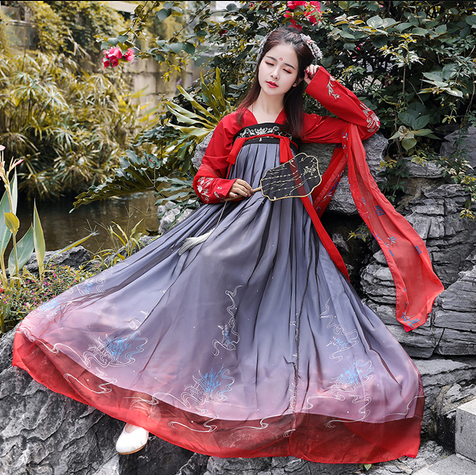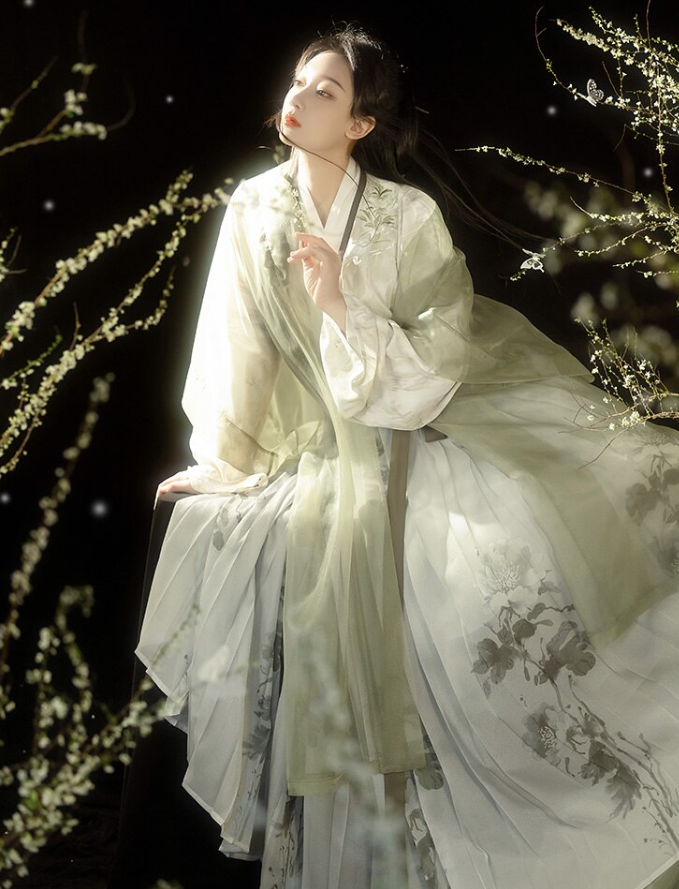Choosing the right colour of Hanfu depends on several factors, including the event you’re attending, your skin tone, and the season.
Understanding Colour Symbolism in Chinese Culture
In Chinese culture, colours aren’t just visual elements; they’re imbued with deep meanings and cultural symbolism. Different shades can represent various emotions, events, and social statuses. Understanding this symbolism can make the experience of wearing Hanfu even more meaningful.

Red: Prosperity and Joy
Red is arguably the most significant colour in Chinese culture, often associated with prosperity, joy, and good fortune. You’ll often see red used extensively during Chinese New Year celebrations and weddings. In the context of Hanfu, wearing red could indicate a sense of celebration or an auspicious occasion. It’s a bold choice that commands attention.
Yellow: Imperial and Sacred
Yellow has long been associated with the imperial family and is considered sacred and exclusive. Historically, commoners were not allowed to wear yellow as it was reserved for the emperor. In modern times, yellow Hanfu can evoke a sense of nobility and high status. This colour is often seen in ceremonies and can make quite an impact.
Green: Growth and Harmony
Green is another popular colour, frequently associated with growth, harmony, and renewal. This makes it an excellent choice for spring events or gatherings focused on new beginnings. Green is also seen as balancing and calming, qualities that can be amplified when wearing Hanfu of this colour.
White: Purity but also Mourning
White is a dual-natured colour in Chinese culture. On one hand, it represents purity and innocence. On the other, it is traditionally worn during mourning periods. In Hanfu, a white garment could be very striking but should be worn with the cultural context in mind. Check the occasion’s appropriateness before opting for white.
Blue: Tranquility and Wisdom
Blue, especially in its darker shades, is associated with tranquility, wisdom, and stability. It is a popular choice for Hanfu meant to be worn in more serene settings or educational events. The colour blue can make the wearer appear wise and calm, a fitting choice for scholarly pursuits or meditative gatherings.
Black: Power and Sophistication
Black is often linked with power, sophistication, and formality. In the world of Hanfu, black can make a statement and often pairs well with brighter colours to create a balanced look. Black Hanfu can be particularly striking at formal events where one wishes to exude an air of authority and elegance.
Seasonal Considerations
The season in which you wear Hanfu can play a pivotal role in the choice of colour. Seasonal considerations aren’t just about matching your outfit with the temperature; it’s also about harmonizing with the emotional and cultural undertones of different times of the year. Let’s delve into how various seasons can affect your choice of Hanfu colour.
Spring: Light and Fresh Colours
Spring is a time of renewal and growth, a season when flowers bloom and the air fills with a sense of new beginnings. In line with this, light and fresh colours like pastel greens, pinks, and blues are popular choices for Hanfu during this time. These shades resonate with the rejuvenating spirit of spring, making them perfect for festivals such as Qingming.
Summer: Bright and Vivid Colours
Summer is all about vibrancy and liveliness. As temperatures rise, so do spirits. Bright and vivid colours like red, orange, and sunny yellow can help encapsulate the energetic vibe of summer. These shades are not only visually striking but also go well with the general atmosphere of outdoor gatherings, picnics, and even Dragon Boat Festival celebrations.
Autumn: Earthy and Warm Colours
When autumn rolls around, the leaves change, and the world takes on a palette of warm, earthy colours. Shades like maroon, ochre, and forest green are exemplary choices for Hanfu in the fall season. These colours not only mirror the natural world but also evoke a sense of comfort and warmth, making them a good fit for gatherings like the Mid-Autumn Festival.

Winter: Deep and Subdued Colours
Winter calls for more muted, deep colours that reflect the introspective mood of the season. Navy blue, deep purples, and rich blacks can be stunning choices for Hanfu during winter. These colours can exude a sense of sophistication and calm, aligning well with quieter, more contemplative gatherings during the Dongzhi Festival or New Year celebrations.
Event-Specific Colours
Choosing the right colour of Hanfu can often be dictated by the type of event you’re attending. Different occasions call for different colour schemes, and being mindful of this can enhance your overall experience. It can also show your cultural awareness and respect for traditional norms. Let’s explore the colours best suited for various types of events.
Weddings and Celebrations
Red is overwhelmingly the colour of choice for weddings and similar joyful events. Its association with good fortune and happiness makes it an ideal pick for such occasions. In many traditional Chinese weddings, you’ll often find the bride in a stunning red Hanfu, symbolizing a bright and prosperous future. Gold accents are also commonly used to symbolize wealth and prosperity. However, in contemporary settings, other auspicious colours like pink and orange can also be seen. These colours work well for not only weddings but also for other celebrations like birthdays and anniversaries.
Funerals and Mourning Events
In stark contrast to the vibrant colours worn during celebrations, white is traditionally worn during funerals or mourning events. This colour symbolizes purity and serves as a gesture of respect for the departed. In some cases, dark blue or black might also be acceptable, as they signify depth and solemnity. When attending a funeral or a memorial service, understanding this colour etiquette can be crucial.
Festivals and Holidays
Festivals and holidays are opportunities to truly embrace a variety of colours. For example, during the Lantern Festival, you can opt for bright yellows, reds, or even multi-coloured Hanfu to match the myriad of lanterns. Similarly, during the Mid-Autumn Festival, warm autumnal colours like oranges and browns could be more appropriate. The key is to harmonize with the spirit of the festival, so feel free to get creative!

Business and Formal Events
For business and other formal events, subtlety is usually the name of the game. Here, dark, muted colours like navy blue, grey, and black can convey a sense of professionalism and seriousness. While traditional Hanfu may not be the standard attire for corporate events, if the occasion allows for it, choosing a Hanfu in these colours can make a lasting impression.
Matching Hanfu with Skin Tone
One often-overlooked aspect of choosing the right Hanfu is considering how well the colour will complement your skin tone. While traditional cultural norms and meanings associated with various colours are important, aligning these colours with your natural hue can elevate your entire look. It enhances not just the aesthetic but also your confidence when wearing Hanfu. Let’s explore how to match Hanfu colours with different skin tones.
Fair Skin Tones
If you have a fair skin tone, you may find that lighter shades and pastel colours tend to complement your complexion well. Soft pinks, light blues, and lavender are excellent choices that create a harmonious look. However, it’s good to balance these softer shades with deeper colours to avoid looking washed out. You might want to avoid too many bright yellows or whites, as they can make fair skin appear even paler. Here’s a useful resource about skin undertones to help you determine what shades will look best on you.
Medium Skin Tones
For those with medium skin tones, earthy colours like olive green, mustard yellow, and terracotta can be exceptionally flattering. These shades can bring out the warmth in your complexion. Jewel tones like emerald green or ruby red can also look stunning, offering a good balance between vibrancy and subtlety. For more ideas, you can look into colour theory to better understand what complements your skin tone.
Dark Skin Tones
If you have a dark skin tone, you have the luxury of pulling off both bright and deep colours incredibly well. Bright hues like fuchsia, cobalt blue, and crisp white can look incredibly striking. On the flip side, deeper shades like plum, dark green, and charcoal can bring a level of sophistication to your Hanfu look. When it comes to metallics, gold accents usually look radiant on darker skin tones.